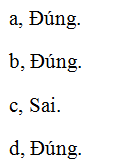Hãy nhập câu hỏi của bạn vào đây, nếu là tài khoản VIP, bạn sẽ được ưu tiên trả lời.

Cho hai véc tơ \(\overrightarrow{a};\overrightarrow{b}\).
TenAnh2
TenAnh2
A = (-4.3, -5.94)
A = (-4.3, -5.94)
A = (-4.3, -5.94)
B = (11.06, -5.94)
B = (11.06, -5.94)
B = (11.06, -5.94)
D = (10.84, -5.94)
D = (10.84, -5.94)
D = (10.84, -5.94)
E = (-4.36, -5.86)
E = (-4.36, -5.86)
E = (-4.36, -5.86)
F = (11, -5.86)
F = (11, -5.86)
F = (11, -5.86)
TenAnh1 TenAnh1 A = (-4.3, -5.94) A = (-4.3, -5.94) A = (-4.3, -5.94) B = (11.06, -5.94) B = (11.06, -5.94) B = (11.06, -5.94) D = (10.84, -5.94) D = (10.84, -5.94) D = (10.84, -5.94) F = (11, -5.86) F = (11, -5.86) F = (11, -5.86) E = (-4.3, -5.98) E = (-4.3, -5.98) E = (-4.3, -5.98) G = (11.06, -5.98) G = (11.06, -5.98) G = (11.06, -5.98)

a) Gọi theo thứ tự ∆1, ∆2, ∆3 là giá của các vectơ ,
,
cùng phương với
=> ∆1 //∆3 ( hoặc ∆1 = ∆3 ) (1)
cùng phương với
=> ∆2 // ∆3 ( hoặc ∆2 = ∆3 ) (2)
Từ (1), (2) suy ra ∆1 // ∆2 ( hoặc ∆1 = ∆2 ), theo định nghĩa hai vectơ ,
cùng phương.
Vậy câu a) đúng.
b) Câu này cũng đúng.

a) Theo giả thiết \(\overrightarrow{a}=\overrightarrow{b}\ne\overrightarrow{0}\) nên giả sử \(\overrightarrow{a}=m\overrightarrow{b}\) suy ra:
\(\overrightarrow{a}=m\overrightarrow{a}\Leftrightarrow\left(1-m\right)\overrightarrow{a}=\overrightarrow{0}\).
\(\Leftrightarrow1-m=0\) (vì \(\overrightarrow{a}\ne\overrightarrow{0}\) ).
\(\Leftrightarrow m=1\).
b) Nếu \(\overrightarrow{a}=-\overrightarrow{b};\overrightarrow{a}\ne\overrightarrow{0}\).
Giả sử \(\overrightarrow{a}=m\overrightarrow{b}\Leftrightarrow\overrightarrow{a}=-m\overrightarrow{a}\)\(\Leftrightarrow\overrightarrow{a}\left(1+m\right)=\overrightarrow{0}\)
\(\Leftrightarrow1+m=0\)\(\Leftrightarrow m=-1\).
c) Do \(\overrightarrow{a}\) , \(\overrightarrow{b}\) cùng hướng nên: \(m>0\).
Mặt khác: \(\overrightarrow{a}=m\overrightarrow{b}\Leftrightarrow\left|\overrightarrow{a}\right|=\left|m\right|.\left|\overrightarrow{b}\right|\)
\(\Leftrightarrow20=5.\left|m\right|\)\(\Leftrightarrow\left|m\right|=4\)
\(\Leftrightarrow m=\pm4\).
Do m > 0 nên m = 4.
d) Do \(\overrightarrow{a},\overrightarrow{b}\) ngược hướng nên m < 0.
\(\left|\overrightarrow{a}\right|=\left|m\right|.\left|\overrightarrow{b}\right|\)\(\Leftrightarrow15=\left|m\right|.3\)\(\Leftrightarrow\left|m\right|=5\)\(\Leftrightarrow m=\pm5\).
Do m < 0 nên m = -5.
e) \(\overrightarrow{a}=\overrightarrow{0};\overrightarrow{b}\ne\overrightarrow{0}\) nên\(\overrightarrow{0}=m.\overrightarrow{b}\). Suy ra m = 0.
g) \(\overrightarrow{a}\ne\overrightarrow{0};\overrightarrow{b}=\overrightarrow{0}\) nên \(\overrightarrow{a}=m.\overrightarrow{0}=\overrightarrow{0}\). Suy ra không tồn tại giá trị m thỏa mãn.
h) \(\overrightarrow{a}=\overrightarrow{0};\overrightarrow{b}=\overrightarrow{0}\) nên \(\overrightarrow{0}=m.\overrightarrow{0}\). Suy ra mọi \(m\in R\) đều thỏa mãn.

Câu 1:
Theo tính chất trọng tâm và đường trung tuyến, ta thấy \(\overrightarrow {AM}; \overrightarrow{GM}\) là 2 vecto cùng phương, cùng hướng và \(AM=3GM\)
\(\Rightarrow \overrightarrow{AM}=3\overrightarrow{GM}\)
\(=\frac{3}{2}(\overrightarrow{GM}+\overrightarrow{GM})\) \(=\frac{3}{2}(\overrightarrow{GB}+\overrightarrow{BM}+\overrightarrow{GC}+\overrightarrow{CM})\)
\(=\frac{3}{2}[(\overrightarrow{GB}+\overrightarrow{GC})+(\overrightarrow{BM}+\overrightarrow{CM})]\)
\(=\frac{3}{2}(\overrightarrow{GB}+\overrightarrow{GC})\) (vecto \(\overrightarrow{BM}; \overrightarrow{CM}\) là 2 vecto đối nhau nên tổng bằng vecto $0$)
Đáp án B
Câu 2:
\(\overrightarrow{u}=\overrightarrow{AB}+\overrightarrow{DC}+\overrightarrow{BD}+\overrightarrow{CA}\)
\(=(\overrightarrow{AB}+\overrightarrow{BD})+(\overrightarrow{DC}+\overrightarrow{CA})=\overrightarrow{AD}+\overrightarrow{DA}\)
\(=\overrightarrow{0}\) (tổng của 2 vecto đối nhau)
Đáp án C
Câu 3:
Bạn nhớ rằng \(\overrightarrow{a}; k\overrightarrow{a}(k\in\mathbb{R})\) luôn là 2 vecto cùng phương (tính chất vecto). Nhưng nó mới chỉ là cùng phương thôi. Muốn cùng phương +cùng hướng thì \(k>0\) ; muốn cùng phương + ngược hướng thì \(k< 0\). Nói chung là phụ thuộc vào tính chất của $k$
Câu C thì hiển nhiên sai.
Nên đáp án B đúng

ta có \(\overrightarrow{x}\) sẽ cùng phương với véctơ đối của nó là \(\overrightarrow{y}=-\left(-2\overrightarrow{a}+\overrightarrow{b}\right)=2\overrightarrow{a}-\overrightarrow{b}\)
\(\Rightarrow A\)